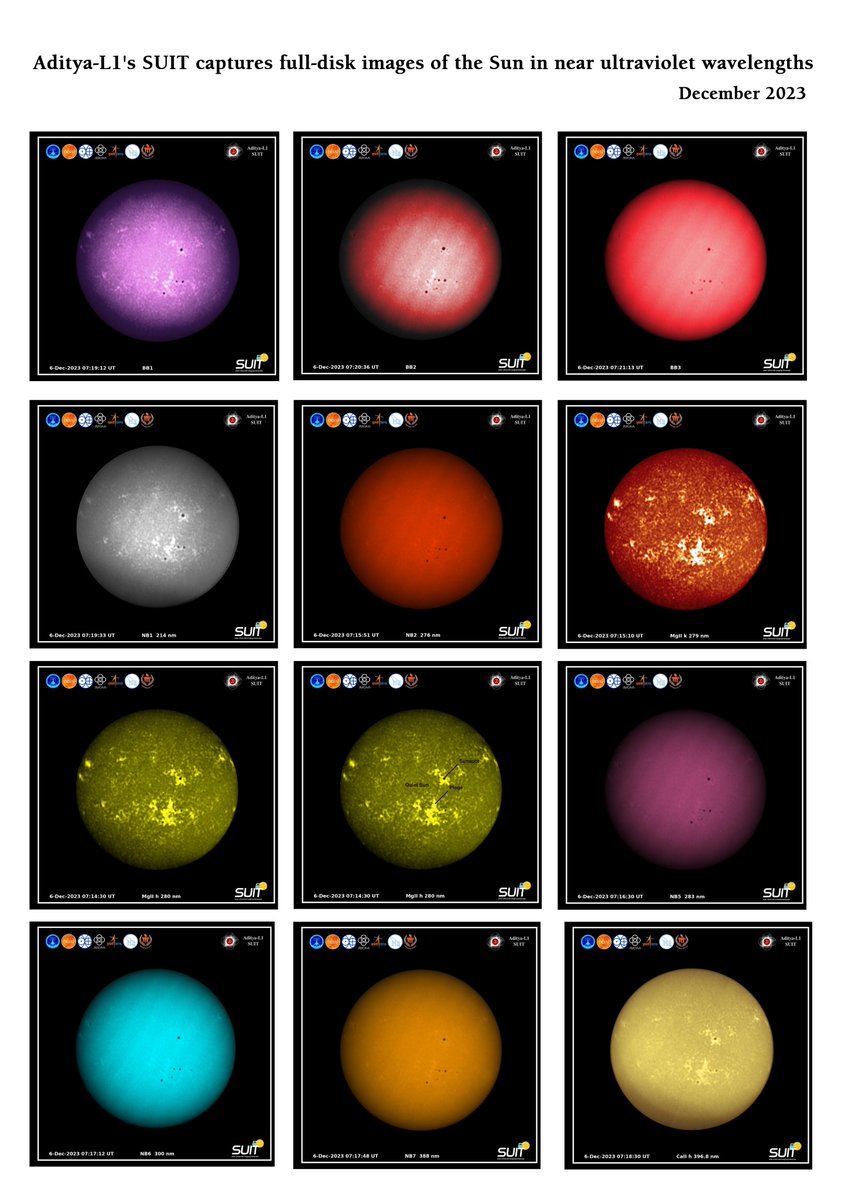ISRO’s Aditya L-1 Mission Marks Milestone with Solar Ultraviolet Imaging Telescope (SUIT) Capturing Stunning Full-Disk Images
Bengaluru, NFAPost: The Indian Space Research Organisation (ISRO) has announced that the Solar Ultraviolet Imaging Telescope (SUIT) aboard the Aditya L-1 spacecraft has successfully captured the first complete images of the Sun’s disk. This momentous feat, achieved on December 8, 2023, provides a crucial glimpse into the intricate dynamics of the solar photosphere and chromosphere, offering scientists unprecedented insights into solar phenomena.
Unlocking Solar Mysteries: SUIT’s Mission
The activation of the SUIT payload on November 20, 2023, marked a pivotal moment in space exploration. Designed to observe the Sun within the ultraviolet spectrum, SUIT is a cutting-edge tool that focuses on the chromosphere and transition region of the Sun. The significance of capturing full-disk representations in the wavelength range of 200-400 nm lies in the ability to unravel the mysteries of solar dynamics, including sunspots, plage, and quiet Sun regions.
A Spectacular View in Ultraviolet
ISRO, in an update shared on X (formerly Twitter), released images captured by SUIT, showcasing the Sun in all its glory. The high-resolution, detailed representations span the ultraviolet spectrum, which extends beyond the visible light range discernible by the human eye. These images, recorded through scientific filters, promise to be a treasure trove for solar physicists and space researchers globally.
Solar Anatomy: Photosphere and Chromosphere Revealed
The solar photosphere, the outermost layer of the Sun’s surface, emits visible light and forms the solar ‘disk.’ With a temperature of approximately 5,500 degrees Celsius, the photosphere contains sunspots—areas with temperatures around 3,500 degrees Celsius due to intense magnetic activity. Above the photosphere lies the chromosphere, a transitional layer with temperatures around 20,000 degrees Celsius. The captured images showcase features such as sunspots, plage, and quiet Sun regions, providing a comprehensive view of these crucial layers.
The Role of Sunspots in Solar Dynamics
Sunspots on the photosphere are shadowed areas resulting from intense magnetic activity. With temperatures lower than their surroundings, sunspots are key indicators of solar phenomena. Their influence extends to solar flares, impacting space weather. The images captured by SUIT offer scientists an opportunity to study these phenomena in unprecedented detail.
SUIT’s Multifaceted Observations
The SUIT instrument, after a successful pre-commissioning phase, recorded its initial scientific images on December 6, 2023. Operating through eleven distinct filters, it produced the first complete views of the Sun in wavelengths from 200 to 400 nm, excluding Ca II h. The exclusion of Ca II h observed at a wavelength of approximately 396.8 nm, is noteworthy, as it allows for studying the Sun’s chromosphere, the layer above the visible surface. While different observatories have previously conducted Ca II h observations, Aditya L-1’s SUIT adds a new dimension to this study.
Collaborative Innovation: SUIT Among Seven Payloads
SUIT stands out among the seven payloads integrated into Aditya-L1. Developed collaboratively by a team of 50 scientists, researchers, and students from various institutions, including the Inter-University Centre for Astronomy and Astrophysics (IUCAA), Manipal Academy of Higher Education (MAHE), CESSI at IISER-Kolkata, Indian Institute of Astrophysics in Bengaluru, Udaipur Solar Observatory (USO-PRL), and Tezpur University in Assam, SUIT represents a synergy of expertise and resources.
Journey to the L-1 Point: Unveiling the Secrets of the Sun
Scheduled to reach the L-1 Point, or Lagrange Point, in the Sun-Earth system in January 2024, Aditya L-1’s strategic positioning within a halo orbit approximately 1.5 million kilometres away from Earth ensures uninterrupted monitoring of the Sun’s behaviour, unaffected by Earth’s atmosphere. Named after mathematician Joseph Louis Lagrange, the L-1 Point discovery is integral to Aditya L-1’s mission, which was launched on September 2, 2023. The mission, spanning 5.2 years, is India’s inaugural attempt to delve into the secrets of the Sun.
Filtered Insights: SUIT’s Observational Parameters
SUIT’s success lies in its ability to capture detailed images through eleven distinct filters, each designed for specific observations:
- NB1 – 214 nm: Photosphere, Sunspot, Plages, limb darkening
- NB2 – 276 nm: Photosphere, Sunspot, Plages, limb darkening
- NB3 (Mg II k) – 279 nm: Chromosphere, Sunspots, Plages, Quiet Sun, filaments
- NB4 (Mg II h) – 280 nm: Chromosphere, Sunspots, Plages, Quiet Sun, filaments
- NB5 – 283 nm: Photosphere, Sunspot, Plages, limb darkening
- NB6 – 300 nm: Photosphere, Sunspot, Plages, limb darkening
- NB7 – 388 nm: Photosphere, Sunspot, limb darkening
- NB8 (Ca II h) – 396.8 nm: Chromosphere, Sunspots, Plages, Quiet Sun
- BB1 – 200-242 nm: Photosphere, limb darkening, Plages, Sunspots
- BB2 – 242-300 nm: Photosphere, limb darkening, Plages, Sunspots
- BB3 – 320-360 nm: Photosphere, limb darkening, Sunspots
These filters allow scientists to study specific aspects of the Sun’s photosphere and chromosphere, contributing to a comprehensive understanding of solar dynamics.
Conclusion: A New Dawn in Solar Exploration
The successful activation of SUIT on Aditya L-1 and the subsequent capture of complete images of the Sun’s disk opened a new chapter in solar exploration. These images, revealing sunspots, plage, and quiet Sun regions, provide scientists with unprecedented opportunities to understand the Sun’s dynamics, unravel solar mysteries, and enhance our knowledge of space weather. As Aditya L-1 continues its journey towards the L-1 Point, the global scientific community eagerly anticipates the wealth of discoveries that lie ahead, marking a historic stride in our quest to comprehend the celestial marvel that powers our solar system—the Sun.




